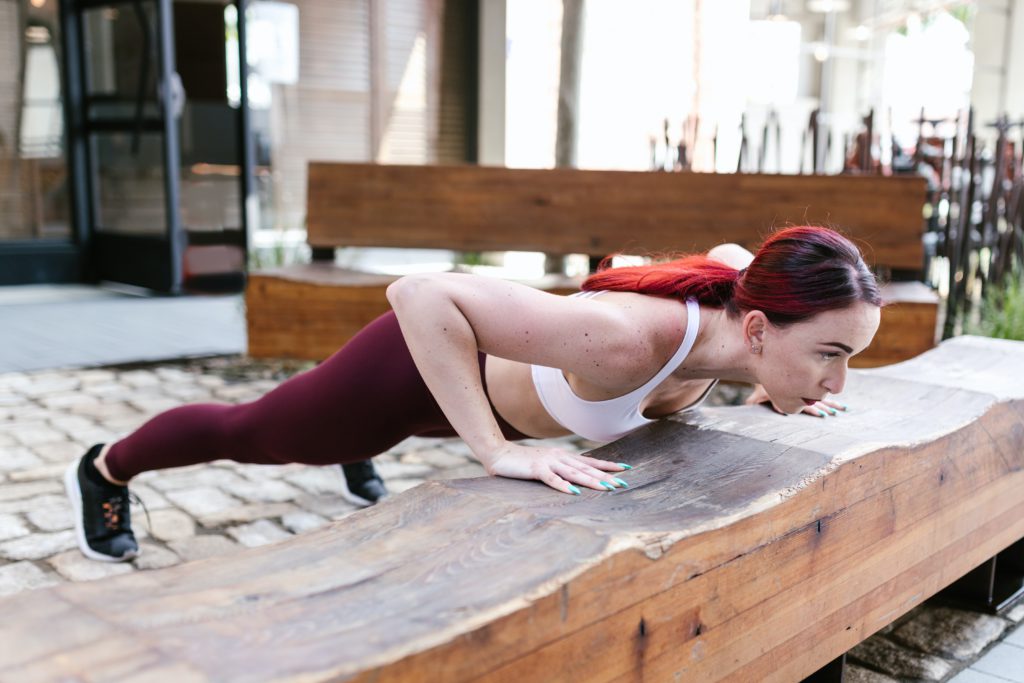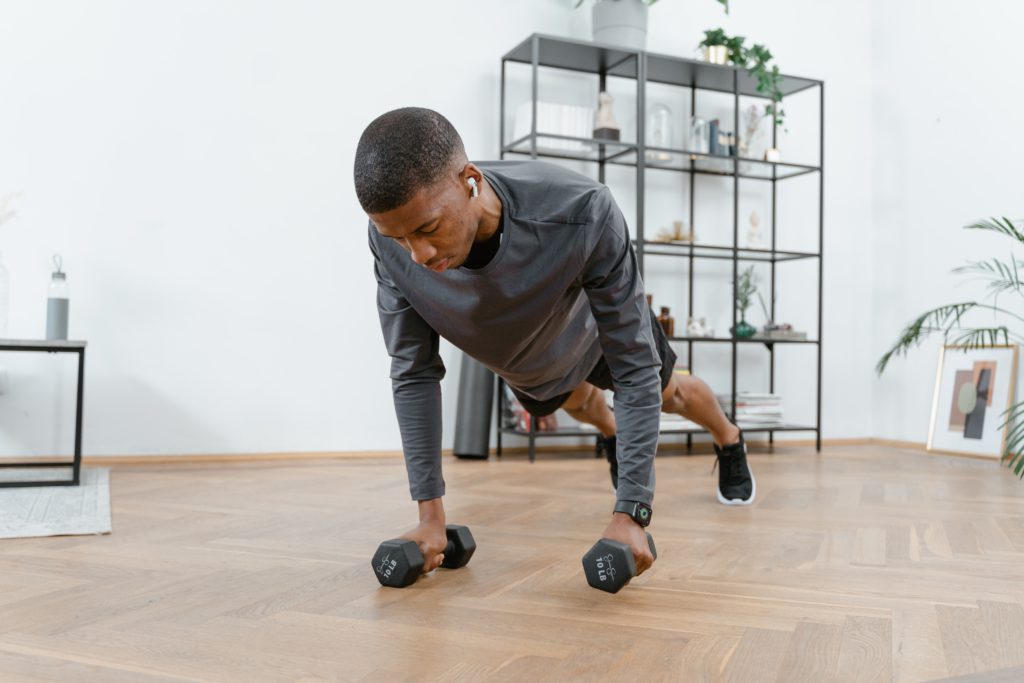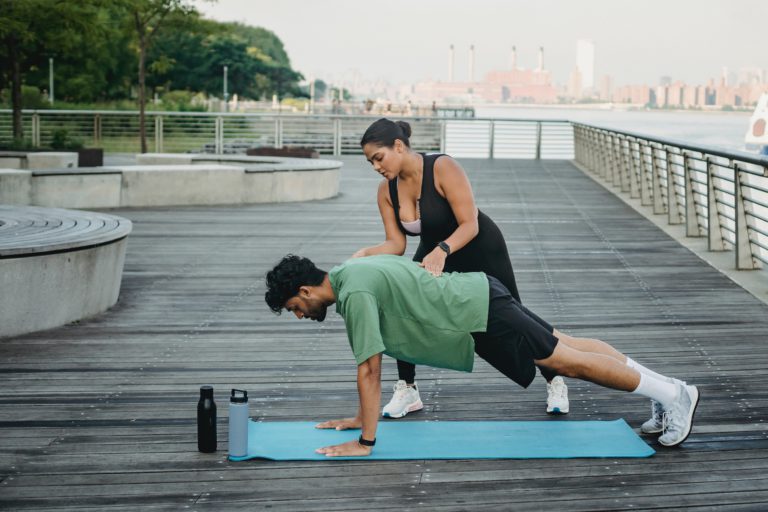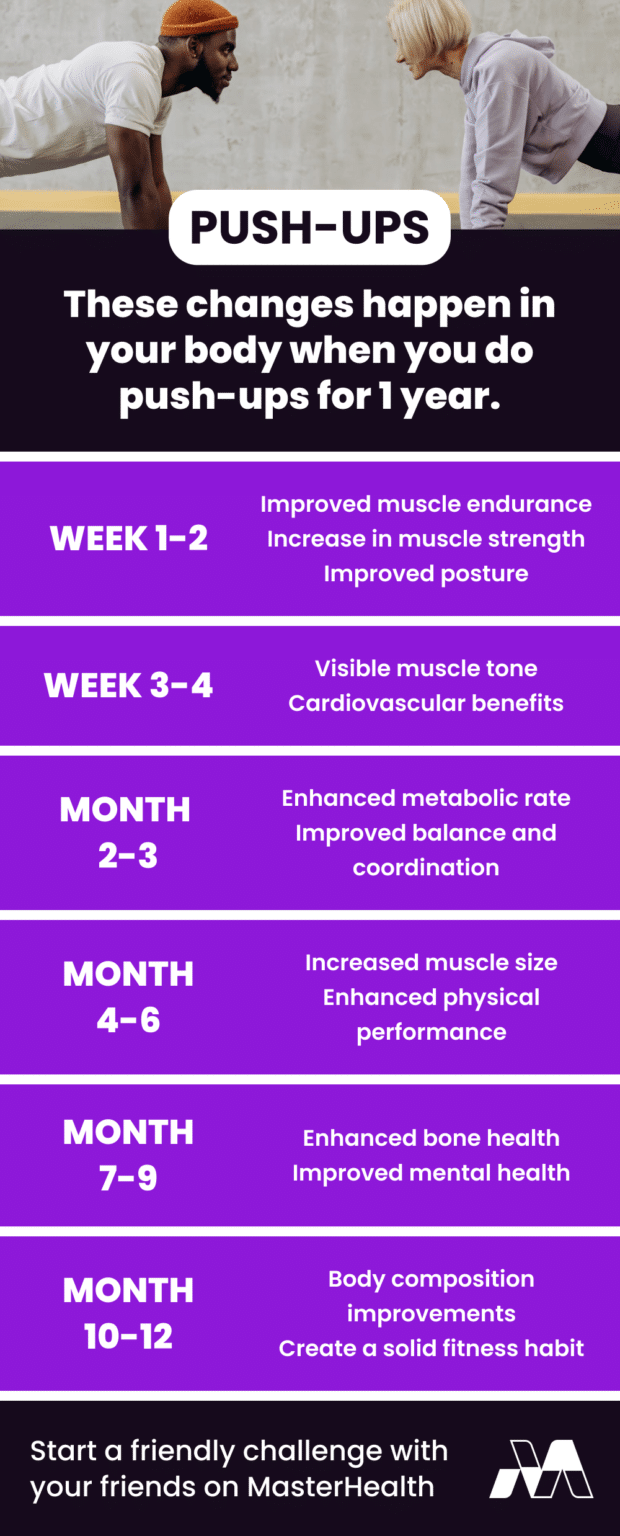
INTRO
What is a push up?

Push ups are a bodyweight exercise that involve using your upper body strength to push your body up and down. To do a push up, start in a plank position on the floor with your hands placed slightly wider than shoulder-width apart and your feet together or hip-width apart.
Keep your body parallel with the floor the entire time, with your hands and feet supporting your weight. Bend your arms to lower your body down until your chest touches the ground, then push back up to the starting position.
Push ups work your chest, triceps, and shoulder muscles, with many health benefits similar to other strength training exercises. Inviting a friend or colleague to join your push up challenge is a great way to keep each other motivated to reach your health goals!
Benefits of Push Ups
Push ups are a popular and effective exercise for improving upper body strength and overall fitness. The best part is that they can be done anywhere because they don’t require any equipment. Some of the health benefits of push ups include:
Improved upper body strength
Push ups work the chest, triceps, and shoulder muscles, helping to build strength and muscle mass in these areas.
Enhanced core stability
The plank position used in push ups requires core stability, which can help to improve your overall stability and balance.
Increased calorie burn
Push ups can be a challenging exercise, and they can help you to burn calories and lose weight.
Expect to see these changes in your body as you do push-ups for 1 year
Doing push-ups consistently has its benefits. You can expect these pretty dramatic changes to happen in your body, along with proper sleep and diet of course, over time when you do push-ups for 1 year!
Pushups for 1-2 weeks
Improved muscle endurance.
You might notice that you’re able to do more repetitions before your muscles tire out.
Increase in muscle strength.
Particularly in your chest, shoulders, triceps, and core.
Improved posture.
Strength in the core and upper body muscles can lead to better posture, as these muscles are important for maintaining spinal alignment.
Pushups for 3-4 weeks
Visible muscle tone.
As you continue to build strength, you may notice more defined muscles in your upper body and core.
Cardiovascular benefits.
As your body adjusts to the exertion, your heart rate at rest may decrease, and your cardiovascular efficiency may improve.
Pushups for 2-3 months
Enhanced metabolic rate.
Regular exercise like push-ups can increase your metabolic rate, potentially aiding in weight loss or maintenance.
Improved balance and coordination.
The stabilization required for push-ups can improve your balance and body coordination over time.
Pushups for 3-4 months
Increased muscle size (hypertrophy).
As you continue to challenge your muscles, you might start to see an increase in muscle size, particularly if you’re also consuming a protein-rich diet.
Enhanced physical performance.
Your overall physical performance in other activities might improve due to the increased strength, endurance, and cardiovascular fitness.
Pushups for 7-9 months
Enhanced bone health.
Weight-bearing exercises like push-ups can stimulate bone cells and help strengthen your wrists, elbows, and shoulders.
Improved mental health.
Regular physical activity can help reduce stress, anxiety, and depression, and improve sleep quality.
Pushups for 10-12 months (1-year)
Body composition improvements.
You may see changes in your body composition, like a decrease in body fat and increase in muscle mass.
Creation of a solid fitness habit.
The act of committing to and performing push-ups regularly for a year is likely to have established a strong routine, making it easier for you to stick to regular physical exercise in the future.
How to do a push up?

The key elements of push ups are:
Proper form. It’s important to maintain proper form when doing push ups to ensure that you’re targeting the correct muscles and reducing your risk of injury.
This includes keeping your body straight, with your hands placed slightly wider than shoulder-width apart and your feet together, and bending your arms to lower your body down until your chest touches the ground.
Intensity. Push ups can be adjusted to suit different fitness levels by adjusting the number of repetitions, sets, or the speed of the movement. As you become stronger, you can increase the intensity to continue challenging your muscles.
Variety. There are many variations of push ups that you can try to keep things interesting and challenge your muscles in different ways. Some options include narrow hand placement, wide hand placement, single arm push ups, or plyometric push ups.
Progression. As you become stronger and more comfortable with push ups, you can gradually increase the number of repetitions or sets, or add in additional variations to continue challenging your muscles.
For extra challenge, try putting weights on your back as you push up, or try incline or decline push ups.
Safety. It’s important to use proper form and technique when doing push ups to reduce the risk of injury. If you have any pre-existing injuries or conditions, you may want to consult with a healthcare professional before starting a push up routine.

What muscles do push ups work?
There are a ton of ways that you can practice push ups to challenge different muscles and keep things interesting. Push ups can be modified to suit different fitness levels by adjusting the hand placement, width of the feet, or by using an incline or decline.
Some variations include:
Adding variations
There are many variations of push ups that you can try, such as plyometric push ups, single arm push ups, or feet-elevated push ups.
Using props
You can use props, such as resistance bands or dumbbells, to add additional resistance to your push ups.

Changing the angle
You can change the angle of your push ups by using an incline or decline to challenge your muscles in different ways.
Adding in additional exercises
Varying the speed
You can vary the speed of your push ups to challenge your muscles in different ways. For example, you can try explosive push ups, where you push up as fast as possible, or slow and controlled push ups, where you take your time and focus on form.
Varying hand placement
You can vary the width of your hand placement to target different muscle groups. For example, narrow hand placement will place more emphasis on your triceps, while wide hand placement will target your chest muscles.
How to Start a Push Up Challenge
1
Start small
Don’t try to do too much too soon. Start with a small number of repetitions and gradually increase as you become stronger and more comfortable.
2
Set specific goals
Having a specific goal, such as being able to do a certain number of push ups or adding in additional variations, can help to motivate you to stay on track.
3
Recruit your friends
Push ups can be more enjoyable and motivating when you have friends to challenge and see who can do more – or hit your goals together. Invite friends, family, or coworkers to your push up challenge so you can hold each other accountable and provide support.
4
Incorporate push ups into your routine
Try to do push ups at the same time each day or week to make it a regular part of your routine.
5
Stay positive
Don’t get discouraged if you have a tough workout or if you don’t see improvement right away. Building a push up habit takes time and practice, so be patient and stay positive.
6
Reward yourself
Celebrate your progress and accomplishments, and reward yourself when you reach your goals. This can help to keep you motivated to continue with your push up challenge.
Pushing Past Setbacks

Like any new habit, it can be hard to stay consistent for a variety of reasons. Here are some tips for overcoming common setbacks when starting your push up challenge.
Lack of motivation. If you’re struggling to get motivated to do push ups, try setting a specific goal or finding a workout buddy to motivate you. You could also try listening to music or a podcast while you workout to make it more enjoyable.
Time constraints. If you’re short on time, try incorporating shorter push up workouts into your routine or combining your workout with other activities, such as running errands or walking the dog.
Lack of strength. If you’re struggling to do push ups, try modifying the exercise to suit your fitness level by using an incline or doing push ups on your knees. As you become stronger, you can gradually increase the intensity.
Physical limitations. If you have physical limitations or injuries, try modifying the push ups to suit your needs or consider switching to a lower-impact exercise.
Plateaus. If you feel like you’re not making progress, try increasing the number of repetitions or sets, or adding in additional variations, like burpees, to challenge your muscles.
Overtraining. If you’re feeling tired or burnt out, it may be a sign that you’re overtraining. Try scaling back on your push up workouts and incorporating more rest and recovery into your routine, like yoga and stretching.
Pushup FAQ’s
The number of pushups you should do in a day depends on your current fitness level, your goals, and your overall exercise routine.
If you’re new to pushups or haven’t done them in a while, we recommend starting with a smaller number of reps and gradually increase as you build strength and endurance. For example, you could start with 3 sets of 5-10 pushups per set and gradually work your way up to doing 3 sets of 20-30 per set.
If you’re already used to doing pushups and are looking to increase your strength and endurance, you could aim for a higher number of reps, such as 50-100 pushups per day, spread out over several sets.
As always, it’s important to listen to your body and not overdo it. Pushups can be a challenging exercise that puts stress on your upper body muscles, so it is important to give yourself enough rest and recovery time between workouts. It is also recommended to consult with a fitness professional or medical provider before starting a new exercise routine.
Planks and push ups are two different exercises that work different muscle groups so it’s hard to equate one to the other.
A plank primarily works your core muscles, including your abdominal muscles, lower back muscles, and hip muscles, whereas push ups work your chest muscles, shoulders, triceps, and core muscles to a lesser extent.
The number of push ups you can do in 1 minute may vary depending on various factors, such as your fitness level, form, and muscle endurance. It’s best to focus on improving your performance in each exercise separately, rather than trying to compare the two.
There are several reasons why you may find it difficult to do a push up. Here are a few possible reasons:
- Lack of strength. Push ups require upper body and core strength to perform. If you have weak muscles in your chest, shoulders, arms, and core, you may find it challenging to lift your body weight off the ground.
- Poor form. If you are not performing the push up with proper form, it can be challenging to execute the exercise. Make sure you are keeping your core engaged, your back straight, and your elbows tucked in close to your body as you lower yourself down and push yourself back up.
- Tight muscles. Tightness in your chest, shoulders, or arms can make it harder to perform push ups. It’s important to stretch and warm up your upper body muscles before attempting push ups.
- Injury or pain. If you have an injury or pain in your upper body, it can make it difficult to perform push ups. Make sure to speak with a healthcare professional before attempting any new exercise if you have a pre-existing condition.
If you are having trouble performing push ups, start with modified push up variations, such as wall push ups or knee push ups, and gradually work your way up to full push ups as you build strength and confidence. It’s also important to be patient and consistent with your exercise routine to see progress over time.
Supporting Your Push Ups
There are many local and virtual support tools that can help you to create and maintain a push up habit. Some options include:
Set specific goals. Having a specific goal, such as being able to do a certain number of push ups or adding in additional variations, can help to motivate you and give you something to work towards.
Hire a coach or personal trainer. A coach or personal trainer can provide guidance, support, and structured training plans to help you reach your push up goals.
Use a push up app. There are many apps available that offer push up workouts and training plans, as well as support and motivation.
Start or join a push up challenge. A MasterHealth pushup challenge is a place where people can connect, share tips, and support one another in their push up journey.
Friend group vs. individuals. Having a friend or loved one join, either in your push up challenge or in person, can make it more enjoyable and help to keep you accountable.












